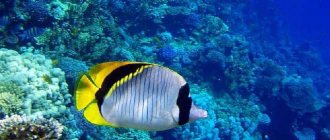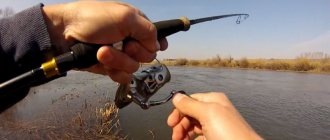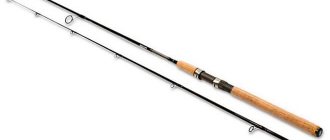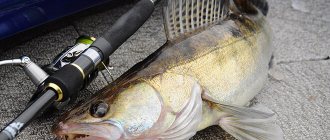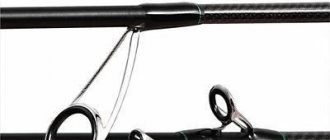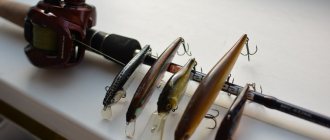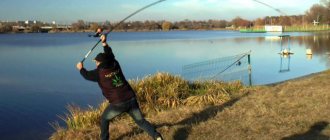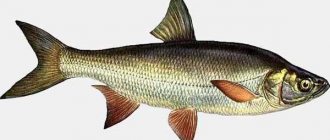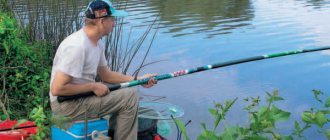Features of sea fishing
Sea fish are superior in strength to the inhabitants of freshwater bodies. Even a small trophy, once hooked, desperately resists. In addition, when fishing in the sea, you need to be prepared for bites from specimens of considerable size, especially if fishing is done from a boat. The weight of predators that may be interested in the bait reaches several hundred kilograms. This must be taken into account when choosing gear.
In the depths of the ocean there is a more active struggle for food resources than in fresh waters. Therefore, the predators that live in them often prefer quick aggressive movements, which are good at provoking them to bite.
In general, sea fishing with a spinning rod involves the use of the same techniques as fishing in fresh waters. Mastering it will not cause difficulties for those who have already mastered the basics of using spinning tackle. This kind of fishing can be combined with a vacation in the south. The Black Sea and Mediterranean coasts, as well as along the shores of any other southern or northern sea, are home to many predators that are constantly looking for food. You just need to present the bait to the fish correctly, and it will not resist the bite.
What kind of fish is found in the Black Sea
About 200 species of fish live in the Black Sea. Some of them, such as blue shark, tuna or swordfish, prefer to stay in the depths, others come close to the shore to feed. Spinning rods most often come across:
- goby;
- scorpionfish, or sea ruff;
- sea crucian;
- greenfinch, or wrasse;
- dog;
- garfish;
- bluefish;
- horse mackerel;
- croaker
These predators hunt in shallow depths and are caught with a spinning rod from the shore.
Spinning rods
The rods that I took with me. I’ll tell you about two models, one of which is far from optimal for the sea for an ordinary person who does not fully master the technique of fishing with ultra-light weights. I was interested in experimenting, so in addition to one rockfish rod Js Company Nixx Rocker 732UL , I took with me an area spinning rod. Rod for fishing pond trout Major Craft Finetail Area 632UL which I planned to use for fishing with jigs and jerk heads up to 1 gram + spinners within the test limits with silicone bait. Yes, I didn’t take any fishing rod with a Solid insert, but as my practice has shown, in the conditions of the Black Sea, tubular tips are absolutely not inferior. But if you have a fishing rod with an insert, of course, feel free to take it.
I’ll say right away, as expected, that the best rod turned out to be the one that was created for rock fishing - the Nixx Rocker. The most powerful butt with a huge margin of safety, which worked from the handle only once, when biting a croaker in the region of 1 kg. All the other fish did not always load the blank from the first ring; the thought that the fish could go into the stones simply did not arise. Great confidence in action. Thanks to the interesting medium-fast action and tubular tip, it works with all types of baits - spinners, wobblers from minnows to deep cranks, lead/tungsten from 1 gram to 5 grams + bait. I threw them a 7 gram jig, #0.3 line (of which there are exactly 100 meters on the spool) flew out so that under the remains of the line the backing veins were visible... Jerk heads weighing up to a gram are frankly not his story (although the test is indicated by the manufacturer from 0.6 gram), begins to work comfortably from 1.5 grams, at two grams of tungsten it opens completely. However, it is worth noting that in fresh water, and even in the current, I fell in love with the Nixx Rocker quite recently; it took me a very long time to ride this stick. I won’t recommend it for fresh water on a current. For a lake - quite enough. For the sea, this is a fairy tale.
And by the way, the fishing was carried out from stone parapets, so this fish had to be lifted with a Nixx Rocker blank to a height of three meters.
Now let's talk about a cool spinning rod for catching pond trout - Major Craft Finetail Area 632UL. A lightweight stick of ultra-slow action, working from the handle already on sea fish weighing less than (!!!) 50 grams. Now on to the features of the fishing rod. Spinner up to 2.5 grams + silicone bait or tungsten 1 gram Cheburashka with a bait of about 1 inch, or a jerk jig head 0.5-0.7 grams - copes well, animates perfectly, perfectly feels the touch of fish on a line #0.2-# 0.25 according to Japanese classification. On a fish of 100 grams it evokes fantastic emotions, comparable to the resistance of 300 grams of fresh perch on the same spinning rod. I stopped fishing with it and gave it to my wife after a bite (most likely a croaker) when fishing vertically in the rocks. A blow, a strong jerk that bent the Fintail at an angle of 90 degrees, a smoking clutch and just the understanding that there is zero restraint in this spinning rod. The fish flies into the rocks at supersonic speed, you are only an observer, but in no way a rival to it. I had to tighten the clutch with 0.2 thread, which naturally led to the fluorocarbon breaking. Well, okay, it happens. The stick is great for its tasks in the rainbow fishing area, I would be happy to use it on rivers/lakes. But at sea you can have fun and catch only greenfinches, blennies, bluefish and small sea crucians with it. And be prepared for the fact that when you meet a cool and powerful fish, in 90% of cases you will have to say goodbye to the trophy without ever seeing it with your own eyes.
The wife got a lot of emotions while fishing for this sea crucian weighing 200 grams. This fish is the limit for the Major Craft Finetail Area.
Conclusion on spinning rods
My advice is to still buy a rockfish spinning rod. I don’t really like stickers, but perhaps in fresh water you’re just used to solid – it’s up to you. Tubular tips are great for all ranges of lures. But I would take “trout” or some “universal” UL fishing rods only if you already have them and you do not have the desire/opportunity to purchase a rockfish model. You must understand that spinning rods for rock fishing, unlike other fishing rods, have a huge restraining resource and power reserve under the same test as conventional “universal” ultralight rods. Although, unfortunately, on store shelves I increasingly see the notorious inscription on the ROCKFISHING form for a couple of three thousand rubles, but in fact, apart from this inscription, there is nothing else in common with this type of fishing. What you need from a spinning rod is the following: the lower half is quite powerful, the middle is of medium action, capable of catching and tying fish. And the tip should be soft and sensitive; it will be a plus if it is painted in light shades, both for greater visibility, including when fishing at dusk and at night, and in order to reduce eye fatigue.
Main fishing spots
At sea they fish from the shore, coastal structures - piers, piers, groins, breakwaters - and from boats.
- Shore fishing is the most popular type of fishing, which can also be called the most sporting. Almost any area of the coast with free access to the water is suitable for it. It is important that at the selected point there are no breakwaters on the way to the open sea - fishing in front of them is practically useless. Where the breakwaters end or there are large openings in them, eddies of water are formed. In such places, predators guard their prey.
- Fishing from structures prominent in the sea has its advantages and disadvantages. The main advantage is the good visibility they provide and the ability to throw bait to fish standing far from the shore. But at the same time, you have to spend a lot of time moving from one groyne to another, and it is difficult to carry out bait at great depths.
- Fishing from boats at sea is done by vertical trolling and trolling. This type of fishing brings big trophies, but many consider it not sporty enough.
Lures
Perhaps the most important part of the article. Oh, there is something to talk about, there is something to write about. Let's go in order from simple to complex.
Let's start with the easiest to learn for a beginner - wobblers. This is the only type of bait for which the fishing experience can be easily transferred from fresh water to the sea. After all, even back in 2014, I didn’t know about such a thing as rock phishing. I just took a box of wobblers (it was terrible, since the sizes of minnow wobblers ranged from 60mm to 90mm) and even with them I was able to catch my first fish. Although if I had understood what needed to be done, my catch would not have ended with two or three scorpionfish in 14 days. I ask you not to repeat my mistakes.
Wobblers
In general, the classic Black Sea wobblers are 30mm-40mm cranks. Even better are dip rolls. I took this information from many articles and videos from famous fishermen. Of course, I listened to her and took with me a box with the appropriate wobblers. Looking ahead, I will say that it was not deep cranks that made my fishing, but several other models. What I had in my arsenal for one crank:
The model names can be seen in the second photo.
Cranks are a cool thing with a powerful game. Threw a crank with a depth of 1.5 - 2 meters and spin the reel. I thought. However, there are nuances. In a bunch of videos that I watched on YouTube there was such a cool and life-saving thing - stopping the wobbler in front of an obstacle (when the wobbler collides with a stone), and during the pause it simply rose above the stone and moved on. Underwater shooting, beauty. It didn't work out that way for me. Initially, there were five more wobblers in this photo. The first tip is not to use deep cranks when fishing from shore in beach conditions! Even the tip of the spinning rod raised up will not always save your favorite wobbler. If you know that the depth in front of you within the casting range exceeds 2 meters, place dips. If not, don't do it. In the videos I watched, authoritative people said that when a crankbait hits the bottom with a shovel, this is an excellent reason for a fish to attack it. Perhaps my curvature played a joke on me, but as soon as the wobbler touched the bottom, in 50% of cases it remained there, and as you can see, the tees were removed due to my dislike of tees and injury to the fish, but one single wobbler is less susceptible to snagging than two tees . I would recommend a depth of up to 1-1.5 meters.
Now specifically about the models.
Strike Pro Cranky Deep 40 is an excellent wobbler that is capable of reaching its working depth of 1.5 meters in 3 (!!!) turns of the reel after you have exhausted the slack that remains after casting. It knocks on the bottom as it should, with a very powerful play of its own, but this model has become the most torn due to its large working depth. Even an ultra-small scorpion fish eats Cranky Deep (at least for me); a goby, who wanted to do something terrible with a wobbler of the same size as himself, got purple several times. I advise you to pay attention to the color A213R, from which all the coastal scorpion fish went crazy at night... But be careful, this color is not visible at all at night.
I also advise you to pay attention to the Candy Crank 40 - the working depth is slightly less than that of the Cranky Deep 40, which makes it possible to use it in shallow water, but the main feature is different. The Candy Crank has a VERY thin blade. Now I’ll explain what’s going on. Due to the very high windage, any crank flies mediocre when casting. It is very difficult, even impossible, to cast such a crank weighing 3.8g and such a large size (40mm + large blade). Your cast will be 30± meters. If the sea is not completely calm (and it usually isn’t, the surf with a wind of 3-4 m/s is already felt as it should be), then when casting such a crank in a wind of 5-6 m/s you place it right at the beginning of the formation of a coastal wave, where the water changes the height and horizon every second. So, an ultra-thin blade cuts through the whitecaps and waves much faster and goes to the working depth, while a regular crankbait sometimes fails to deepen in such conditions. Look for similar baits with the thinnest possible blade, which will make your life easier .
Cranks are a cool thing if conditions permit. Or rather depth. My conditions in Tuapse did not quite allow it, fishing was constantly carried out on the beach, so I will tell you about my wobblers, which in an unexpected way became the favorites of the trip, while the well-deserved recognition of the cranks began to increasingly remain in the box due to the fact that they were torn off in times easier.
Kids with a depth of up to a meter are really cool things.
There are only 4 models in front of you. It’s not all that simple, but it’s much more interesting than with cranks. There is something to be said about each model. I’ll start with the most difficult wobbler to “control” - Baby Pro 25F. The wobbler causes so many hits from small horse mackerel that it becomes even embarrassing for the Japanese jerking heads. The question is the implementation of these undercuts. The hook for small mackerel of 20-40 grams is too big, I didn’t have less than an assist, the mackerel often turned purple. His trick is a powerful superficial play with a depth of only 10-20 centimeters. They get into a flock of horse mackerel - bites and pokes from the first seconds of posting. With such depth, you can safely fish from the shore - it’s impossible to tear it off. A few words about the “control” of the wobbler: due to the very small depth in conditions of moderate surf or slight sea conditions, it often flies out on the wave and the wiring gets lost. Only one thing helps - a very long fluorocarbon leader, which will sink it a couple of centimeters due to its negative buoyancy and keep the tip of the rod as low as possible. If you come across a flock of horse mackerel weighing 50-100 grams, you will be happy.
Next, a few words about the smallest one in my arsenal, Crazy Plankton. It is slightly smaller than the Baby Pro 25 - its size is only 21 mm. It is very easy to operate such a model - it is a suspender with a depth of 40 centimeters. However, what is most interesting is that horse mackerel was not very interested in it, but small bluefish responded perfectly, especially to dark colors. Perhaps this is due to the fact that the horizon of 10-20 cm is occupied by horse mackerel, but it no longer wants to go down to 40 cm. Crazy Plankton flies well, copes well with waves and probably would have shown even better results, but I was stuck with the remaining two models: the evil Archback 35SP and the leader of my trip, My Turn 31SP. I would like to write a lot about them, but at the same time be concise. I’ll try to explain it this way: twitching the Archback 35SP is a pleasure, and it doesn’t matter - from the shore, or from rocks, the height of which reaches a meter above the water. Personally, I pulled it along stone embankments and piers. The number of scorpionfish taken both along the pier and in shallow water is off the charts. There were problems with the sale of smaller fish such as bluefish and blennies, since I removed the small treble hooks and set one powerful assist - I was still hoping for a trophy fish, and my single hook simply did not fit into the small mouth of the other inhabitants. I will confidently give the Archback 35SP silver.
Scorpena is the main client of Archback 35SP
The hit from my box of wobblers, as I said above, is My Turn 31 SP. Definitely. Comes with a nice Owner single hook. Working depth is 50 centimeters, keeps the game in all conditions. In addition to the sea, I visited a mountain river and persuaded a micro-chub to use this wobbler. The strong current did not bother him. An interesting thing happened in the sea - My Turn attacked sea crucian carp, which always pecked exclusively on rubber. The fishing for bluefish and scorpionfish is excellent, and in the daytime. What made the scorpionfish rise almost to the surface during the day to attack the wobbler is a mystery.
Conclusion on wobblers
I gave recommendations on the sizes and types of wobblers. In my case, all the wobblers were from Strike Pro, with which I am very friendly and have complete confidence in the wobblers. Your choice may differ from mine, but there should be one base - these are 30-40mm cranks with a depth of 0.5 to 2 meters, 25-35mm minnows that respond well to twitching and baby cranks from 20 to 30mm with a depth of up to 80cm and with its powerful play in a small size.
Sea spinning
For fishing in the sea, high-strength gear is used. The length of the rod is selected based on the fishing conditions. Suitable spinning rod sizes are from 1.8 to 3 m. Short rods are suitable for fishing in the ocean depths from a boat, and long rods are used for coastal fishing, as they allow long casts.
There are special sea spinning rods designed for fishing in salt water. They resist its aggressive effects well thanks to the use of special materials and coatings. They also use ordinary gear designed for fishing in freshwater bodies, but after each fishing it is advisable to thoroughly rinse them to remove any remaining salt.
Based on what characteristics is the choice made?
In order to quickly master the technique of casting and retrieving, experienced professionals always advise beginners to start with universal rods. Their advantage is that the tackle is suitable for fishing from the shore and boats. It is possible to use a wide range of baits of different weights. An example of the indicators of such a spinning rod: length 2.4 m, test for baits from 5 to 25 g.
But such versatility hides disadvantages:
- Reduced comfort of fishing from a boat. The optimal length is considered to be from 1.8 to 2.1 m.
- Light lures will not reach the target distance. They are practically not felt when wiring.
- The use of heavy jig heads and other baits weighing more than 20 g is unacceptable, as the risk of putting an increased load on the rod increases. Over time, it can cause gear failure.
As a training rod for practicing casting techniques, casting distance accuracy, or simply as a spare tackle, this is a good option. But it’s better not to waste money and buy several rods with working properties for different fishing conditions and types of predatory fish.
In addition, there are other points to consider before purchasing:
- body of water with or without current;
- bait immersion depth;
- shore fishing or from a boat;
- estimated size, type of fish;
- types of baits used.
Below we will analyze the features of the main indicators.
How long should it be
Spinning rods are produced with a length of 1.8 to 4 m. But the specific choice is determined by the nuances of fishing:
- For coastal fishing on rivers and reservoirs up to 120 m wide, an excellent option with a length of 2.1 to 2.7 m.
- Tackle over 2.7 m long is useful for fishing on large deep-water rivers, reservoirs, lakes, where the casting range reaches 100 m or more.
- For a boat, 1.9 m is best.
Having decided on the length, you need to move on to analyzing other indicators.
Bait test
The working property of a spinning rod, by which the fisherman determines the upper and lower weight limits of the baits used. The lower limit of the test indicates the minimum permissible weight of a wobbler, spoon or jig head. In the case when the specified indicator and the mass of the bait are equal, then when performing the retrieve, the fisherman will feel the fullness of its unique game. If the weight of the bait is less than the lower test, then even an experienced master will not feel the bait during retrieving.
The upper limit of the test indicates the maximum permissible weight of the bait. When a fisherman decides to ignore this value and take, say, a spoon of greater mass, then during casting this can cause a breakdown. It is important to remember that not all manufacturers conscientiously indicate the test gear up to 1 g, in particular, the lower limit.
The test is divided into:
- ultra-light – from 1 to 5 g;
- light – from 5 to 15 g;
- medium - from 7 to 25 g;
- heavy – over 20 g.
For example, an ultralight rod with a test weight of 1 to 5 g allows you to use light baits for small and medium-sized fish (perch, ruff). But with a competent and unhurried approach to fishing, and an adjusted reel clutch, experienced fishermen manage to catch large pike or pike perch using ultralight.
For fishing on small rivers from shallow depths, a rod with light or medium test is sufficient. For deep-sea reservoirs, you need to take gear with a dough of 20 g and above. When trolling, only large baits are used, so the spinning rod is taken with a heavy test so that it can easily withstand and feel the play of bait weighing over 60 g. There are gear options where, instead of a test, manufacturers indicate a range of breaking loads.
Material of manufacture
There are several types:
There is an opinion among fishermen that the high content of carbon fiber in a fishing rod makes it very fragile when used in winter conditions and increases the risk of breakage. Therefore, for fishing during the first severe frosts, it is better to take gear with a medium content of carbon fiber modulus.
What is a system and how to choose it
The structure is called the Young's modulus of elasticity coefficient. This indicator shows the time it takes to return to the starting position after casting the rod. The sensitivity of the gear depends on the system. When fishing with a hard spinning rod, the fisherman feels all the vibrations. But as this parameter increases, the casting range decreases
The classification of rod action is as follows:
- Extra Fast – very fast. Flexibility up to ¼ of the tackle length. Not designed for long casts. Does not soften the jerks of fish when playing.
- Fast - fast. Flexibility up to ½ length. Fishermen call it a “half” formation.
- Moderate - average. Flexibility up to ¾ of the length of the tackle.
- Slow - slow. The form bends along its entire length. Another name is “parabolic” system. Of all types, it is characterized by the longest cast. It softens the jerks of the fish well when playing, thereby reducing the load on the fishing line.
Among fishermen, fast and medium action are considered popular.
Stage 1.
We determine the place of fishing. Boat or shore fishing. Reservoir size.
Test
The upper limit of the permissible weight of spinning baits for fishing from the shore can be from 3 to 50 grams. Tests of rods for fishing in the open sea reach several tens of kilograms. This parameter is selected based on the mass of baits and loads used.
Sea fishing reels
For sea fishing, spinning reels of size 1000 and above and multipliers are used. Inertia-free baits are easy to use and allow long-distance casting of light baits. They are best suited for catching small fish from the shore.
Multiplier reels are designed primarily for hunting trophy predators at great depths. They are durable and powerful. Such reels can withstand the resistance of trophy fish well and allow you to confidently pull them towards the boat.
Sea fishing line
To catch small sea fish from the shore, braid with a diameter of 0.1−0.14 mm or monofilament with a thickness of 0.18−0.22 mm is sufficient. Braided line allows you to make long casts and provides the gear with the sensitivity necessary to control the action of the bait.
Also, thanks to the small diameter of the braid, the bait sinks to the bottom more easily, which allows you to comfortably catch sea predators at great depths.
How to choose a spinning rod for a beginner?
Stage 1.
We determine the place of fishing. Boat or shore fishing. Reservoir size.
Stage 2.
We decide on the type of spinning fishing (jig, twitching, spinner, microjig).
Stage 3.
Select a spinning test.
Stage 4.
Choose a comfortable spinning rod handle (Eva, cork, solid, spaced, skeletal type).
Stage 5.
We select a suitable reel and install it on the spinning rod. We evaluate how the rod fits in the hand and check the balance.
Stage 6.
Let's try spinning on "shakes". It is necessary to make several swings with the spinning rod - this will give the angler an idea of how the rod behaves dynamically, and some idea of the structure. Of course, you can fully understand how a spinning rod works only by heavily loading it while fishing.
Stage 7.
We inspect the ring inserts and the rod blank. We check for defects (dents, scratches, abrasions, delamination of the form)
Stage 8.
We choose a line suitable for the spinning rod and fishing conditions. Rod tube and reel case.
Stage 9.
We check the assembled kit on a pond.
How to understand the test, rod classes, lengths, materials and other characteristics of a spinning rod? Let's look at everything step by step.
Spinning rod marking
Baits for fishing from the shore
For spinning fishing from the shore use:
- silicone baits. Both standard twisters and vibrotails, as well as crustaceans, octopus and other original shapes, are suitable. They can be used with standard jig equipment or with a bombard. Combing the bottom with a stepped sweep brings good results, but when fishing in rocky places you need to be prepared for snags. Bombards can be floating, slowly sinking and quickly sinking and allow you to fish respectively at the surface, in the middle layers of water and at the bottom.
- Wobblers. More often, heavy wobblers with large blades are used, which go deep to 3-4 meters and attract goby, scorpionfish, horse mackerel, croaker and other sea predators. Floating models and wobblers with a slight depth are suitable for catching garfish.
- Oscillating spinners. The main advantage of these baits is their flight qualities. Jigs are especially well suited for shore fishing, as they can be cast over long distances, catching promising points from the shore.
Lures for fishing from a boat
For fishing from a boat, casting uses the same baits that are used in shore fishing - silicone, wobblers and oscillating spoons. In this case, you need to select larger models and heavier loads.
So, if you fish from the shore with a jig with weights weighing from 3 g, then for fishing from a boat you will need heads weighing at least 20-30 g. Jigs are well suited for vertical lures.
